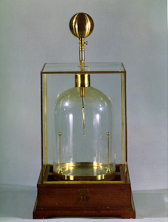
52.5 x 27.3
Glass, gold and wood
CAT 1878 : 364
Electrometro condensador de Volta.
Volta condenser electrometer.
This apparatus consists of a brass sphere which communicates with the interior of a glass bell jar by means of a brass rod; two gold leaves are suspended from the lower end of the rod. When an electrically charged body is brought near to the sphere, without touching it, the gold leaves repel one another because the charged body induces distribution of electrical charges. The sphere has a charge opposite to that of the charged body, the leaves have charge opposite to that of the sphere. If, in these conditions, we connect the electrometer's sphere to the ground, and then disconnect it, afterwards removing the charged body, we see that the gold leaves remain apart owing to the repulsion force resulting from the distribution of the electrometer's charge. In these conditions, the electrometer has a charge opposite to that of the charged body.
The spheres at the top of the two small rods standing on the plate at the base of the apparatus are to accentuate the repulsion between the gold leaves, owing to the electrical induction to which they are subject. They thus increase the apparatus' sensitivity. The charge distribution on the spheres is opposite to that of the charge on the electrometer's leaves. This effect is increased considerably if the rods are connected to the ground through the brass plate on which they are fixed.
To reduce the harmful effects of humidity on electrostatic experiments, the electrometer is mounted on a wooden box which contains a dish of anhydrous lime, which can be removed by means of a drawer. The bell-jar is enclosed by a glass case which communicates with the inside of the wooden base via four wide openings in the upper part.
The Gabinete de Física acquired this Volta condenser electrometer in 1868.
Daguin, Pierre-Adolph, Traité Élémentaire de Physique Théorique et Expérimentale, Paris, 1878, Vol. III, n.º 1672, Fig. 1169.
Ganot, A., Traité Élémentaire de Physique, 19th edition, Paris, 1884, p. 870, Figs. 777 and 778.